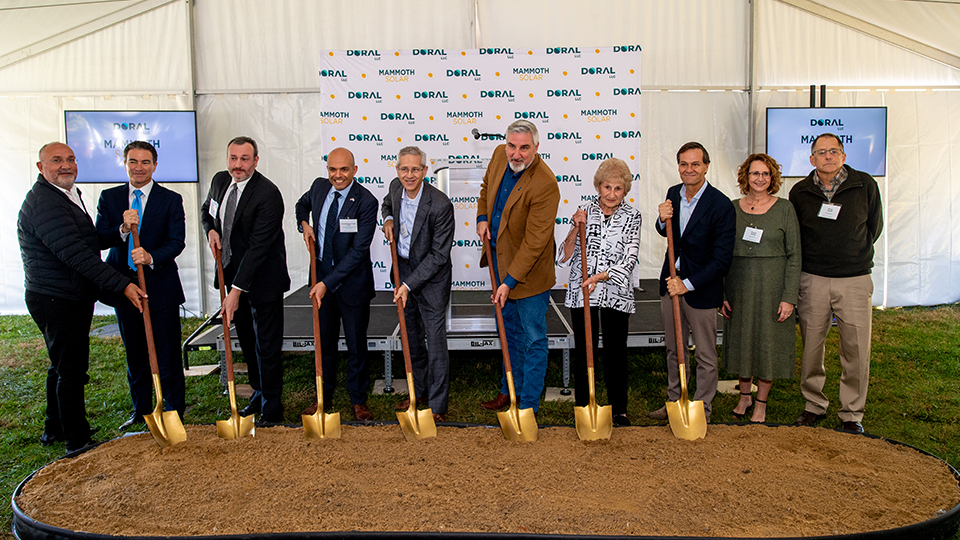Mammoth Solar enters next phase of $1.5B project
Subscriber Benefit
As a subscriber you can listen to articles at work, in the car, or while you work out. Subscribe Now
FRANCESVILLE, Ind. - Israel-based Doral Renewables LLC hosted a ceremonial event Thursday in the Pulaski County town of Francesville to mark the start of construction on the second phase of Mammoth Solar, a $1.5 billion solar farm in northwest Indiana. Mammoth South will be in Pulaski County, while Mammoth North, which is under construction, is entirely in Starke County. The company broke ground on the first of three phases in October 2021 and expects the northern project to be operational in late 2023.
In an interview with Inside INdiana Business, Doral Renewables Senior Vice President of Development Kevin Parzyck said lessons learned during the first phase will help with the next round.
“We’ve learned little bits and pieces, means and methods within the region, how to best source everything from materials to labor,” said Parzyck. “And we’re going to be applying that now to the next phase. As you move along, within a community, it keeps getting more and more refined as to how we do the work.”
LISTEN: Parzyck updates Inside INdiana Business reporter Alex Brown on the first two phases of the project.
The first phase of the project represents a $475 million investment that will produce 400 megawatts of electricity when it becomes operational, which is expected to be in late 2023. Doral says constructions crews have been installing posts and frames which will hold the solar panels.
While the project is on schedule, according to Parzyck, the company has run into challenges with sourcing the solar panels. He called it a problem “at the federal level.”
“There’s been a lot of dialogue with China sourcing of materials of panels. And, and that’s probably been the biggest thing that has been going on for the past year,” said Parzyck.
Fortunately, he says Doral has been able to secure the other necessary materials, such as cabling, posts and frames.
“If anything, the panel deliveries have been delayed. But that’s kind of a global issue,” said Parzyck.
He says the company has been able to work with the contractor to keep construction going with the necessary infrastructure installation.
As far as phase two, Parzyck expects crews will start moving dirt next March and complete the project by mid-2024.

“Clean energy projects like Mammoth Solar will be critical to our energy source portfolio and to powering leading industries like agbiosciences and the advanced manufacturing as we seek to grow and attract them both. We’ll do this as we simultaneously work to increase the quality of life and place in our neighborhoods and communities for years to come,” said Governor Eric Holcomb.
While not committing to a specific timeline for phase three, Parzyck said it would likely occur in 2025. He says Mammoth Central will also be developed in Pulaski County and produce 600 MW of power overall.
“You know, we continue to feel that the environment is excellent, you know, with the direction of Governor Holcomb the direction we’ve been, we’ve worked very closely with the state, the support from the community is great,” said Parzyck. “The interconnection is great, the solar resources great. It’s a very good area to build in the areas are flat there. They’re readily available for solar, it’s easy to build solar on these flat farmlands.”
Doral says the 1.3-gigawatt Mammoth Solar project will create about a dozen full-time jobs, post-construction, and ultimately generate enough clean energy to power 175,000 homes in Indiana and Illinois.
Ohio-based American Electric Power Co. (Nasdaq: AEP), which owns Fort Wayne-based Indiana and Michigan Power, has already inked power purchase agreements for the first and second phases of the project.
Editor’s note: Governor Eric Holcomb attended the Mammoth Solar project ceremony. He’ll appear on this weekend’s edition of Inside INdiana Business with Gerry Dick to discuss his upcoming trip to Egypt to attend the United Nations’ Climate Change Conference where he’ll discuss Indiana’s work with renewable energy infrastructure.
